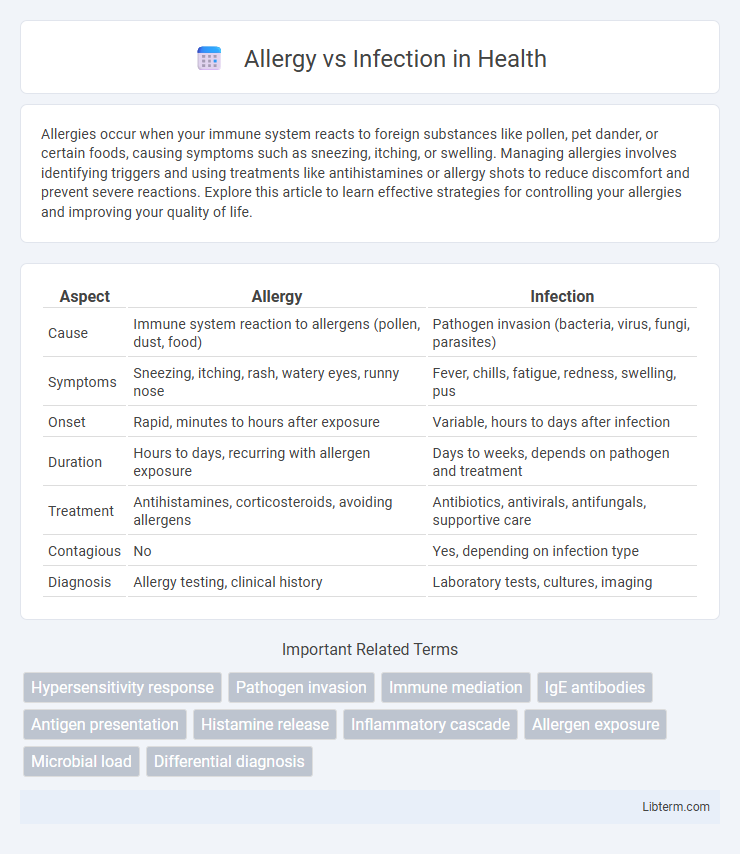Allergies occur when your immune system reacts to foreign substances like pollen, pet dander, or certain foods, causing symptoms such as sneezing, itching, or swelling. Managing allergies involves identifying triggers and using treatments like antihistamines or allergy shots to reduce discomfort and prevent severe reactions. Explore this article to learn effective strategies for controlling your allergies and improving your quality of life.
Table of Comparison
| Aspect | Allergy | Infection |
|---|---|---|
| Cause | Immune system reaction to allergens (pollen, dust, food) | Pathogen invasion (bacteria, virus, fungi, parasites) |
| Symptoms | Sneezing, itching, rash, watery eyes, runny nose | Fever, chills, fatigue, redness, swelling, pus |
| Onset | Rapid, minutes to hours after exposure | Variable, hours to days after infection |
| Duration | Hours to days, recurring with allergen exposure | Days to weeks, depends on pathogen and treatment |
| Treatment | Antihistamines, corticosteroids, avoiding allergens | Antibiotics, antivirals, antifungals, supportive care |
| Contagious | No | Yes, depending on infection type |
| Diagnosis | Allergy testing, clinical history | Laboratory tests, cultures, imaging |
Understanding Allergies and Infections
Allergies occur when the immune system overreacts to harmless substances like pollen or pet dander, triggering symptoms such as sneezing, itching, and inflammation. Infections involve the invasion of harmful pathogens like bacteria, viruses, or fungi, leading to immune responses aimed at eliminating these foreign invaders. Distinguishing between allergies and infections is crucial for effective treatment, as allergies require antihistamines or immunotherapy, while infections need antimicrobial medications.
Causes: Allergens vs. Pathogens
Allergies are caused by allergens such as pollen, pet dander, mold, and certain foods that trigger an immune system overreaction without infection. Infections result from pathogens including bacteria, viruses, fungi, and parasites invading and multiplying in the body. Understanding the distinct causes helps differentiate allergic reactions from infectious diseases and guides appropriate treatment strategies.
Key Symptoms: How They Differ
Allergy symptoms typically include sneezing, itching, watery eyes, and nasal congestion without fever, whereas infection symptoms often involve fever, body aches, and purulent mucus. Allergic reactions trigger an immune response to harmless substances like pollen or pet dander, while infections result from bacteria, viruses, or fungi invading the body. Distinguishing between the two is crucial for appropriate treatment, as allergies respond to antihistamines and infections may require antibiotics or antivirals.
How the Immune System Responds
The immune system responds to allergies by producing Immunoglobulin E (IgE) antibodies that trigger the release of histamines, causing inflammation and typical allergic symptoms such as itching, swelling, and mucus production. In contrast, during an infection, the immune system activates white blood cells like macrophages and T-cells to identify, attack, and eliminate pathogens such as bacteria, viruses, or fungi. While allergies involve a hypersensitive immune response to harmless substances, infections provoke a targeted immune defense aimed at eradicating harmful microorganisms.
Common Types of Allergies and Infections
Common types of allergies include hay fever (allergic rhinitis), food allergies, insect sting allergies, and drug allergies, which trigger immune system hypersensitivity reactions. Infections commonly involve bacterial infections like strep throat, viral infections such as the flu or common cold, and fungal infections like athlete's foot. Differentiating between allergies and infections is crucial as allergies do not involve pathogens, whereas infections result from bacteria, viruses, fungi, or parasites invading the body.
Diagnosis: Allergy Tests vs. Infection Detection
Diagnosis of allergies primarily relies on allergy tests such as skin prick tests and specific IgE blood tests, which identify immune system reactions to allergens. Infection detection involves laboratory techniques like cultures, PCR assays, and serological tests to pinpoint pathogens such as bacteria, viruses, or fungi. Accurate differentiation between allergy and infection is crucial for targeted treatment, preventing unnecessary use of antibiotics or improper management.
Treatment Approaches for Each Condition
Allergy treatments primarily involve antihistamines, corticosteroids, and allergen avoidance to reduce immune system overreactions to harmless substances. Infection therapies depend on the causative pathogen, using antibiotics for bacterial infections, antivirals for viral infections, and antifungals for fungal infections, targeting and eliminating the infectious agent. Immunotherapy may be used in allergy cases to build tolerance, while infections often require symptom management alongside pathogen-specific medications.
Prevention Strategies for Allergies and Infections
Effective prevention strategies for allergies include minimizing exposure to known allergens such as pollen, dust mites, pet dander, and certain foods while using air purifiers and maintaining clean living environments. Infection prevention relies heavily on regular handwashing, vaccination, and practicing good hygiene to reduce the transmission of bacteria, viruses, and other pathogens. Both allergy and infection prevention benefit from early identification and management, including the use of medications like antihistamines for allergies and antibiotics or antivirals for infections when necessary.
When to Seek Medical Help
Seek medical help for allergies when symptoms include difficulty breathing, swelling of the face or throat, persistent hives, or severe reactions following exposure to allergens. Infections require prompt medical attention if there is high fever, prolonged pain, persistent redness or swelling, or signs of systemic involvement such as confusion or rapid heartbeat. Early diagnosis and treatment of both conditions are essential to prevent complications and ensure effective management tailored to the specific cause.
Managing Allergy and Infection Risks
Effective management of allergy and infection risks involves identifying triggers and implementing preventive measures such as avoiding allergens and practicing good hygiene. Using medications like antihistamines for allergies and antibiotics for bacterial infections can control symptoms and prevent complications. Immunizations and tailored allergy treatments such as immunotherapy further reduce the risk and severity of both conditions.
Allergy Infographic

 libterm.com
libterm.com